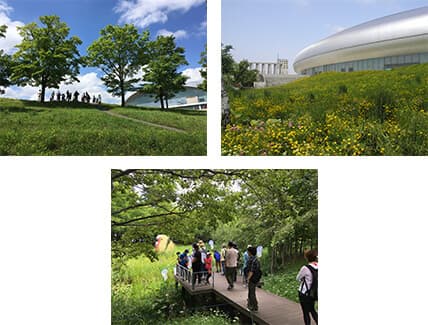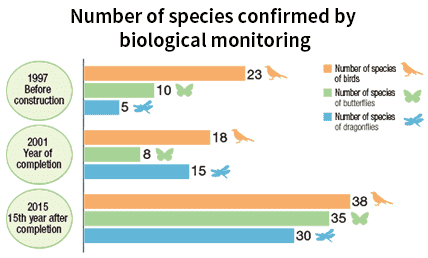- HOME
- Environment(E)
- Realization of a Sustainable and Environmentally Friendly Society
- Nature Co-Existing Society
For Realization of a Nature Co-Existing Society
Policies and Basic Approach
The TAISEI Group has established the Group's long-term environmental target "TAISEI Green Target 2050" to "Realization of a Sustainable and Environmentally Friendly Society" as stated in the Environmental Policy, which defines our responsibilities, contributions through our business and initiatives toward the realization of a nature co-existing society. The "Fundamental Concept" is described in the Environmental Policy.
Responsibilities
As construction is the core business of the Taisei Group, the Group has a keen awareness of the effect of its business activities on the transition to a nature -co-existing society and the impact of the transition to a nature -co-existing society on business activities. We observe the Declaration of Biodiversity Preservation by Taisei Group and consider it to be our responsibility to minimize the negative impact of construction business on the natural environment and biodiversity.
Contribution Through Our Business Activities
The Taisei Group identifies the risks and opportunities in anticipation of the achievement of a nature co-existing society. We strive to develop and disseminate technologies and services relating to conserving and restoring natural environments and enhancing biodiversity, and to promote activities that, co-exist with nature and maximize the positive impact on the natural environment and biodiversity, in order to contribute to the realization of a nature co-existing society.
Risks and Opportunities
Achieving nature-positivity by protecting and leveraging natural capital and biodiversity, which are fundamental to our planet's sustainability and human security, is a major global priority. Companies are expected to contribute to achieving a nature-positive society. The construction industry is closely linked to nature. Many construction materials, such as steel bars and frames, cement and concrete, sand, glass, and timber, rely heavily on natural resources. While construction activities negatively impact natural capital through land alteration and fragmentation, they also positively impact urban environments by creating nature. We joined the TNFD Forum in June 2022, endorsed the TNFD recommendations, and were listed as a TNFD Early Adopter in January 2024.
If the transition to a nature co-existing society stalls and the decline in natural capital continues, our group may face risks such as increased material costs due to resource shortages and higher costs due to increased environmental charges. Additionally, inadequate efforts by our group may lead to lower evaluations from stakeholders and reduced business opportunities.
On the other hand, transitioning to a nature co-existing society is expected to increase opportunities for our group to increase contracts related to concerning and creating rich natural environments as well as developing green infrastructure, all of which contribute to nature-positivity. Our initiatives to develop and implement these technologies and services will help us to secure and enhance our competitive advantage.
We believe that transitioning to a nature co-existing society presents opportunities for enhancing corporate value and improving evaluations from stakeholders.
Information Disclosure of Integrated Environmental Management(TCFD/TNFD)
Policies/Commitments
- Action Guidelines for Taisei Personnel: Promoting environmental conservation and creation nature co-existing
- Environmental Policy
- TAISEI Green Target 2050: Realization of a nature co-existing society
- Promise of Eco-First
- Declaration of Biodiversity Preservation by Taisei Group
- Taisei Group Guidelines for Conservation of Biodiversity
- Taisei Group Green Procurement Guideline
- Taisei Group Green Procurement Standard Guideline
- Taisei Group Sustainable Procurement Guidelines
- [TAISEI VISION 2030] Achievement Plan
Policy on Business Foundation Development: Sustainability Management Strategy (Environment and Energy)
Goals
TAISEI Green Target 2050: Group's long-term environmental targets
Achieving and deepening Nature Positive
- To minimize negative impact of construction business
- To maximize positive impact of business in harmony with nature
2030 Environmental Target
- Offering proposals and projects that contribute to Nature Positive
- Promotion of projects : 50 or more per year
- Development of evaluation method:Implementation of evaluation on 30% of design and construction projects
- Respond to marine issues
Roadmap

KPIs
- As to KPIs, please refer to Materiality.
Initiatives
- United Nations Global Compact “Environment”
- Initiative based on the Declaration of Biodiversity by Keidanren (Japan Business Federation, Keidanren Committee onNature Conservation)
- Tokyo Greenship Action (Bureau of Environment, Tokyo Metropolitan Government)
- Japan Business Initiative for Biodiversity (JBIB)
- 30 by 30 Alliance for Biodiversity (Ministry of the Environment)
- TNFD Forum
Participation in Initiatives
The Tokyo Greenship Action project
- Since FY 2003, the Tokyo Metropolitan Government Environment Bureau has conducted activities to preserve natural environments in cooperation with private companies, NPOs, governments and so on in several of the 50 regions of Tokyo Prefecture that have been designated as “conservation areas,” and uses these areas as venues for the Sustainability activities of private companies. Taisei is in agreement with this initiative, and for more than 10 years the company has participated in the Tokyo Greenship Action project to preserve greenery in Nanakuniyama.
The Japan Business Initiative for Biodiversity (JBIB)*
- The JBIB is an organization of companies set up in 2008 to promote active efforts aimed at preserving biodiversity. As a member of the JBIB network, Taisei promotes activities to preserve biodiversity by sharing information regarding the Promotion Guidelines for ABINC registered company and the Association for Business Innovation in harmony with Nature and Community (ABINC) and communicating with member companies.
*Organization of Japanese companies engaged in activities to preserve biodiversity
The Japan Business and Biodiversity Partnership
- Taisei participates in the Japan Business and Biodiversity Partnership as a member company,cooperating with NPOs,NGOs,research institutions and other relevant organizations both at home and abroad to promote corporate activities aimed at preserving biodiversity. Our Group have made biodiversity conservation in Taisei Group Sustainable Procurement Guidelines on the supply chain and is pursuing measures accordingly.
30 by 30 Alliance for Biodiversity
The TNFD Forum
Eco-First Commitment
Participation in Eco-First Council
In May 2012, TAISEI Corporation submitted to the Minister of the Environment an Eco-First Commitment and was certified as an Eco-First Company, and the company is steadily executing its commitment. TAISEI serves as the coordinator of the Eco-First Promotion Council which is made up of the 94 (as of March 2024) companies that have been certified as Eco-First Companies. We are working to strengthen cooperation with the Ministry of the Environment and the other Eco-First Companies to resolve environmental issues such as achieving carbon neutrality, a circular economy and nature positivity.
Activities / Efforts
Natural environments consist of a variety of interconnected environment ranging from remote mountains and satoyama (undeveloped woodlands near populated areas) to cities and the sea. TAISEI Corporation is working to preserve and create diverse good natural environments and green infrastructure in order to achieve and deepen nature positivity.
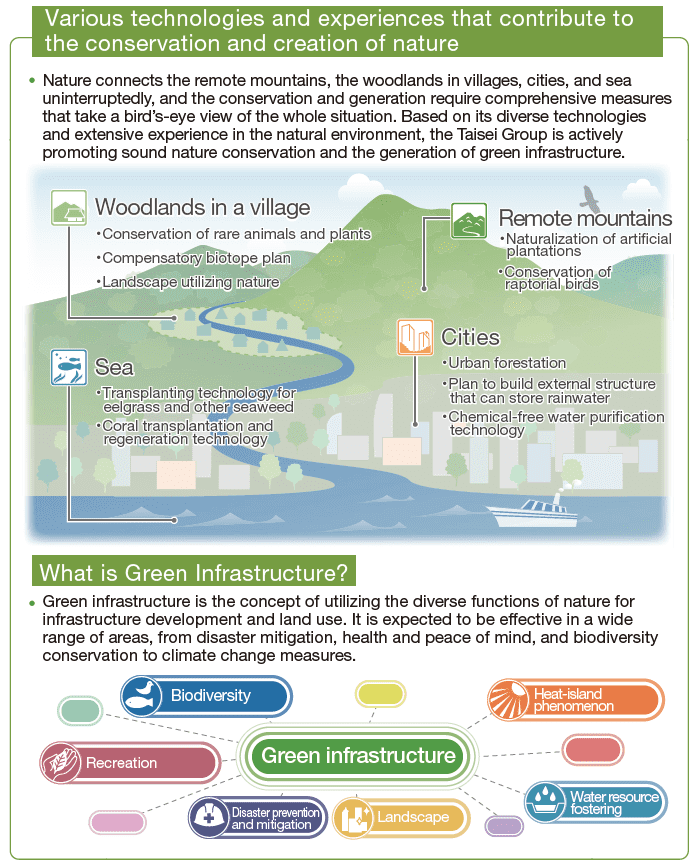
Promotion of Green Infrastructure
Shinagawa Season Terrace
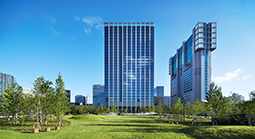
(Photo: Forward Stoke inc.)
- The Shinagawa Season Terrace is a building complex that effectively uses the land above the site of the Shibaura Water Reclamation Center. To ensure that contaminated rainwater does not flow directly into the ocean, a rainwater storage pond was constructed beneath the Water Reclamation Center to temporarily hold the water that falls initially during torrential downpours. In addition, the artificial ground that was built at ground level has been provided with a vast green area that cools the breezes blowing from Tokyo Bay before they reach the city center. This open space of water and greenery forms a green infrastructure that makes use of water, wind and greenery.
Taisei Group Guidelines for Conservation of Biodiversity
The Biodiversity Guidelines constitute guidelines for action in three major areas: company-wide activities, planning and design activities, and procurement and construction activities. By proposing and deploying water resource and biodiversity-related technologies, we are working to reducing the consumption of water resources and reducing the environmental impact of construction in accordance with the guidelines.
we also provide employees with regular environmental training and conduct environmental preservation activities in order to contribute to society.
Biodiversity-Conscious Research, Planning, Construction and Monitoring
Taisei Corporation has adopted a system for identifying risks relating to biodiversity at the construction planning stage and following up on them throughout the entire process from construction through completion. Taisei's ecological planning, one of the company's proprietary environmental planning technologies, has been formulated and executed in all projects in which consideration for ecosystems is judged to be needed.
Ecological Planning is the equivalent of the Biodiversity Action Plan (BAP) in the Convention on Biological Diversity. Taisei uses its various technologies to study and analyze the environment at the construction site and the surrounding area, and then drafts and executes a plan based on regional characteristics in an effort to construct good quality social capital. Monitoring is conducted following completion and the results are used as feedback for technological improvement.
These tools make it possible to easily determine the environment at construction sites and share this information to appropriately preserve and create natural environments.
Natural Environment Conservation
Initiatives for Sustainable Virtuous Cycles in Local Communities Implemented by the Taisei Group
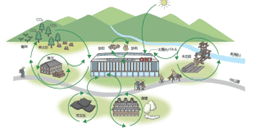
We jointly participated in the activities to build a forest circulation system for the H1 Building of the Oki Honjo Plant. For the facility, we actively used timber from the Arakawa River basin in Chichibu. We are also engaged in a tree planting initiative by bearing part of the cost to reforest the area where timber has been sourced. We are contributing to forest recycling by working with our customers and local communities to recover forests and recycle forest resources for the future.
Environmental DNA
- With DNA analysis technology derived from organisms contained in water and soil, we conducted a continuous habitat survey of rare amphibians (salamanders, etc.) living in the conservation target areas around construction sites. This analysis technology enables continuous monitoring of the underwater inhabitation status after the spawning season, which was difficult with conventional visual surveys.
Creating forests from saplings designed to resemble a natural forest
In the development of Fujisan Nanjyo Industrial Park, trees suitable for the regional environment were used to conduct "10-year forest creation" designed to resemble a natural forest. Saplings were planted in a tree-planting ceremony, using "nature-conscious greening" techniques to nurture a forest with trees that compete with one another. It has been confirmed that, ten years after planting, a forest has been formed with richer biodiversity than the remaining forest that surrounds it. (Recipient of the FY2020 Japan Society of Civil Engineers Environment Award, 49th Environment Award, Minister of the Environment Award)
Preserving and Creating Natural Environments to Achieve Nature Positive
Kure City General Waste Disposal Site
The general waste final treatment plant, Eco Globe Kure, was completed and began operations in 2015 as a place to express and communicate nature restoration technologies.
To preserve living things that have been lost to development in the satoyama environment, a preservation plan was drafted based on surveys, and a compensatory biotope was created. A subsequent survey confirmed the presence of the living things that were the objects of conservation.
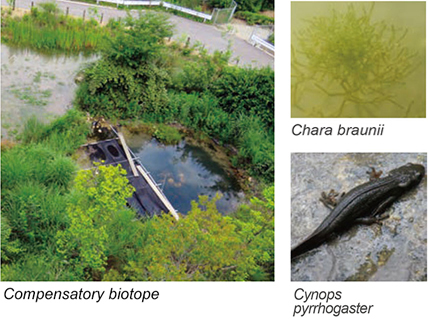
Sapporo Dome (Sapporo City, Hokkaido)
Ongoing monitoring survey
In the planning stages for the construction of Sapporo Dome in 1997, consideration for nature was one of the design conditions, as the site that was planned for construction was adjacent to a residential area and Hitsujigaoka, a place with a rich natural environment. Accordingly, with the aim of creating an environment that would be used by an even more diverse array of living things, ecological planning techniques were used to propose planning conditions and create a bio-friendly outdoor facility plan.
Long-term monitoring was initiated when the facility was put into operation in 2001 and has continued to this day. Monitoring has confirmed the presence of many varieties of birds that had been set as indicators. Moreover, the varieties of birds, butterflies and dragonflies have increased since the planning stages, and biodiversity is even greater than before construction began, confirming that the created environment is contributing to nature positivity.
Knowledge and concrete results accumulated during this process have been used for the development of the biodiversity communication tools, the “Ikimono (living creatures) Concierge,” and have contributed to the conservation and sustainable use of natural resources through various environmental awareness activities conducted by Sapporo Dome Co., Ltd.
Improvement of Facility Value through Biodiversity Conservation and Creation
-The ESR Amagasaki Distribution Center
An environmental certification that proves natural environmental consciousness of a facility increases the value of the facility and appeals to customers as proof of an environmentally conscious company.
Leveraging its strength as a general construction firm capable of executing projects from start to finish, from the planning and design of facilities to their construction, Taisei Corporation conducts environmental assessments of projects, including the impact on biodiversity, from the early stages of development planning, and incorporates consideration for the environment into project plans. In so doing, we strive to minimize environmental impacts and support our clients' environmental activities, such as the conservation and creation of biodiversity as well as the acquisition of environmental certifications.
At the stage of planning and design of the ESR Amagasaki Distribution Center (ordered by ESR), a logistic facility located at the Osaka bay-side area, for example, an outer green area was planned, designed, and constructed by Taisei Corporation to help improve the biodiversity without affecting capabilities as a logistics facility.
The facility earned the “Business Innovation in Harmony with Nature and Community” certification from the Association for Business Innovation in Harmony with Nature and Community (ABINC) as a logistics facility that respects biodiversity.

Creating Nature in Urban Environments
Otemachi Tower and Otemachi Forest
A natural forest designed to match the character of the location was created in the center of Tokyo to restore both the city and nature. Otemachi Forest provides multifaceted functions as a part of the green infrastructure of the urban sphere. It offers a place of rest and relaxation to people coming and going in the business district, helps to ease the "heat island" phenomenon, and contributes to the ecosystem network.
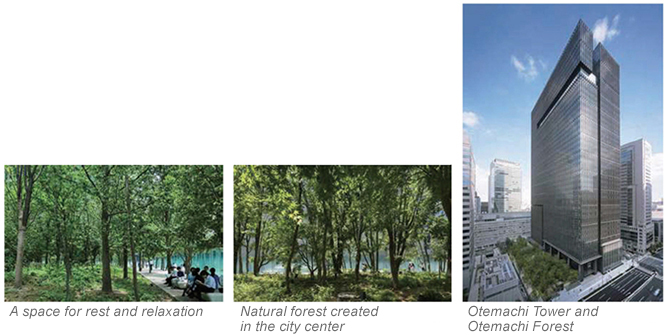
The Okura Tokyo
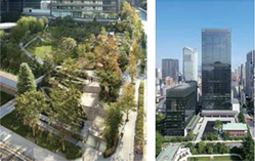
The Japanese aesthetics that have been refined since ancient times were used as the concept for the design of the exterior space. These aesthetics will carve out a new history as regional scenery that creates new value for society.
Restoring Ocean and Water Environments
Eelgrass transplantation technique
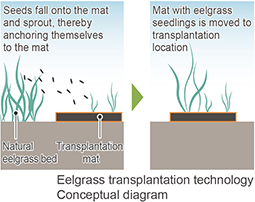
This is a simple transplantation technique for eelgrass (Zostera marina) that requires no seeding or stock planting. A mat made of palm fibers is placed in a natural eelgrass bed, and eelgrass seedlings fall naturally onto the mat and sprout, anchoring themselves to the mat. The mat is then simply moved to the transplantation location. In ocean tests, this method has been confirmed to achieve propagation and growth that is equivalent to that of natural eelgrass.
Coral transplantation technology
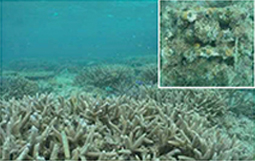
This technology uses coral egg-laying to induce propagation. Incubated and hatched coral larvae are colonized to implantation devices to propagate. TAISEI has developed a concrete implantation device that is cheaper than conventional ceramic implantation devices. These devices can be used to preserve and create highly diverse coral reefs in the same manner as natural coral reefs are created.
Consideration of Biodiversity for Proposal (risk assessment)
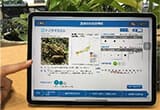
During civil engineering construction, there are many chances to face the natural environment. Therefore, we propose measures to protect endangered animals and plants and avoid having an influence on them considering biodiversity. As for construction, our biodiversity evaluation tools such as “IKIMONO-Concierge®” “MORI-Concierge®” and “Mizube-Concierge®” are effectively used for greening plans at construction sites or for redevelopment projects.
*Concierge Series
- Ikimono Concierge®:Our unique tool for predicting and identifying animals that can be attracted by a planning site.
- Mori Concierge®:Our unique tool enabling the selection of plants that can adapt to the environment of a planned site.
- Mizube Concierge®:Our tool for developing a unique plan to conserve and compensate for waterside rare fauna and flora whose ecosystems may be affected by construction.
Dialogue and Cooperation with Stakeholder
Making dormouse nest boxes
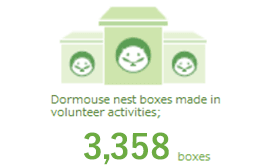
- Taisei Corporation has supported for Dormouse & Wildlife Institute that conserves wildlife, such as Japanese dormouse. Since 2005, on the occasion of building animal-pathway in Hokuto City, Yamanashi prefecture, we have started providing environmental learning to our employees and have participated in volunteer activities. We have build nest boxes while learning about dormouse through volunteer activities and donated a total of 3,538 dormouse nest boxes.
In addition, we participated in crowdfunding for an animation project to raise awareness about roadkill issues related to small arboreal animals and animal pathways. This anime, "Promise of the Forest: Yamane's Tale," which raises awareness about animal pathways, was released.
TAISEI 1 Ton CLUB
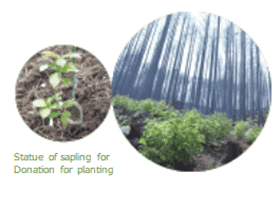
- Since 2010, we have conducted this environmetal contribution activity a total of 12 times, under the theme of “simultaneously achieving carbon offsets at the Company and in the homes of employees.” In 2012 and 2015, we supported the Kamaishi Forest Owner's Association, which manages the mountain forests of Unosumai District. In May 2017, a large-scale wildfire occurred in the district due to a suspicious fire, resulting in the burning of 413 hectares as well as heavy damage. Therefore, since 2017, we have been conducting in-house fundraising to collect donations to purchase seedlings to revive forest in Kamaishi. For FY2023, we gathered 1,538,500 yen in voluntary donations from 1,115 employees.

